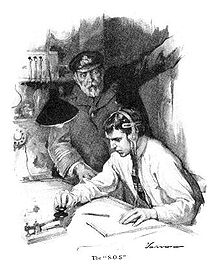
Back إس أو إس Arabic SOS Azerbaijani SOS Byelorussian SOS BE-X-OLD SOS Bulgarian এসওএস Bengali/Bangla SOS Catalan ئێس ئۆ ئێس CKB SOS Czech SOS Danish

SOS (· · · — — — · · ·) is a Morse code. It is used as distress code, to signal danger. It was introduced by the German government in radio regulations on April 1, 1905. It became the worldwide standard when it was included in the second International Radiotelegraphic Convention, which was signed on November 3, 1906. The convention became effective on July 1, 1908.
From the beginning, the SOS distress signal has actually been a continuous sequence of three-dits/three-dahs/three-dits, all run together without letter spacing. In International Morse Code, three dits form the letter S, and three dahs make the letter O, so "SOS" became an easy way to remember the correct order of the dits and dahs. In modern terminology, SOS is a "procedural signal" or "prosign", and the formal way to write it is with a bar above the letters. It should be written SOS.
In popular usage, SOS became associated with phrases such as "Save Our Souls", "Save our Ship", and others. It is mostly known by "Save Our Ship". However, these phrases were a later development, most likely as a Mnemonic to help remember the correct letters—something known as a backronym. In reality the signal SOS is not an acronym and doesn't stand for anything.
Many songs have been made of the distress signal SOS, such as "Message in a Bottle" by The Police, "SOS" by ABBA, "SOS" by Rihanna, "S.O.S." by the Jonas Brothers, "Stranger" by Gamma, "S.O.S" by The Suicide Machines, "S.O.S" by Ola Svensson and "SOS" by Avicii.